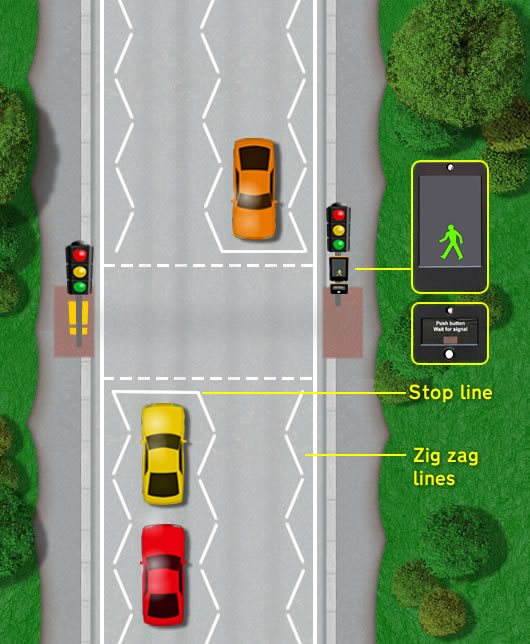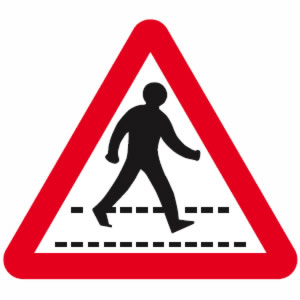The rules for drivers at Puffin Crossings are similar to other light controlled pedestrian crossings. It is important however to know the difference for the theory test, if you are new to UK roads or if you are a learner driver.
There are five main types of pedestrian crossing in the UK and the driving test routes will certainly incorporate many of the different types.
The driving examiners have strict rules when it comes to pedestrian crossings and many tests are failed due to these. Knowing the correct rules not only as a pedestrian, but as a driver is essential if you wish to pass the driving test and of course, remain a safe driver.
Difference between Pelican and Puffin Crossing
One reason that differentiates a Pelican from a Puffin crossing is a Pelican uses a predetermined time to allow pedestrians to cross.
A puffin Crossing uses cameras mounted on or close to the lights to detect pedestrians in the waiting area and on the actual road crossing and so the duration at which cars are stationary to allow pedestrians to cross is determined by how many pedestrians need to cross. The lights only change to green for vehicles when the crossing is clear and not set on a specific duration of time like Pelican Crossings. The time Puffin Crossings allow pedestrians to cross is within reason and after a period will permit traffic to continue. Both Pelican and Puffin Crossings need to be activated by the button on the control panel.
As the Puffin Crossing does not use a predetermined time for pedestrians to cross the road, it aids in increasing traffic flow. If a solitary person uses a Puffin Crossing, it is likely to allow traffic to proceed sooner than a Pelican Crossing. As the cameras detect the Puffin Crossing is clear, there is also no need for the flashing amber phase used in Pelicans.
Another feature of the Puffin, is unlike the Pelican, it does not have the green and red man on the opposite side of the road. These are located on the control panel, facing the traffic close to where the pedestrian pressed the button. This is a safety feature that encourages pedestrians to check there is no approaching traffic before crossing.
Dealing with a Puffin Crossing Whilst driving
Whether driving generally or during a test, always look well ahead for pedestrian crossing signs. If a sign has been put in place (see left column), it will give you advance warning of the crossing hazard ahead and allow you plenty of time to prepare. As the crossing gets closer keep a keen eye for pedestrians waiting at the crossing or any cyclists. If they have been waiting for some time, the chances are the lights will change.

The driving examiner will be expecting interior mirror checks from you to establish if anything is behind you and how close. If you are anticipating the crossing lights might change and a vehicle is driving close behind you, ease off the accelerator gently as you get closer to the crossing. If you need to stop, it will give the car behind more time to react.
Also to give you advanced warning, you can sometimes see the ‘wait’ sign on the crossing control panel if the button has been pressed. this is especially noticeably at night.
If the crossing is clear and you are confident the lights will not change, there is no need to slow down and you can continue at normal speed. If the lights on the Puffin crossing change and you need to stop, ensure you do so at the solid line closest to you (see stop line on diagram). If you stop over or on this line, or stop in a cyclist waiting box (if the crossing is located at a junction), the examiner is likely to fail your test. Ensure you do not stop on the crossing area.
Stopping a vehicle on the crossing area is a traffic offence and will of course fail a driving test. If the roads are busy and traffic is moving slowly, ensure the car in front has sufficiently cleared the crossing and also leaves plenty of room for you to clear the crossing the other side before you proceed.
A Puffin Crossing does not have a flashing amber. Once the lights change from red to red/amber, look up and down the crossing to ensure it is clear from pedestrians and cyclists before proceeding.
Failing to stop at a red light
If on a driving test the examiner is expecting you to anticipate the actions of road users and pedestrians ahead, including pedestrian crossings. Failing to stop at a red light will of course fail a driving test and if a traffic offence. Cameras are occasionally mounted on Puffin Crossing to catch offenders who fail to stop at red lights. Such offences can lead to points on a driving licence (including a provisional) and a fine.
Puffin Crossing rules
- Steady amber lights on a Puffin Crossing tell you to slow down and prepare to stop.
- The zigzag lines painted either side of the road on a Puffin Crossing are areas where vehicles are not permitted to park. Parking in these areas obstructs the view of the crossing to other drivers and increases the chances of accidents to both drivers and pedestrians.
- The Puffin Crossing area must be kept clear at all times to allow the safe passage of pedestrians. Stopping in this area is hazardous for pedestrians and will certainly fail a driving test. If police are present or cameras are mounted on the crossing, a fine and penalty points may be incurred.
- Overtaking another vehicle on a Puffin Crossing is not permitted.
- Hand gestures or other signals to tell pedestrians to move across a Puffin Crossing should be avoided and are a common cause of accidents.
- It is illegal not to stop at a red light at a Puffin Crossing.
Puffin Crossing lights
This Puffin Crossing light sequence below shows what a driver will see at the same time as a pedestrian. Remember there is a steady amber on Puffin Crossings only and no flashing amber that are used on Pelican Crossings.


Puffin Crossing steady amber
The steady amber phase of a Puffin Crossing signals drivers to prepare to stop. If whilst driving, you drive through a steady amber because you are close to the crossing, this is acceptable providing you do not drive through a red light at any point (even half way through crossing).

Puffin Crossing sign
Puffin Crossing road signs may be in place to warn you of a pedestrian crossing ahead. Not all pedestrian crossing have signs warning motorists, though most in busy areas do. Always look well ahead for pedestrian crossing signs as this will provide you with plenty of warning of the hazard.
Puffin Crossing zigzag lines
The Zigzag lines on the road at each side of a Puffin Crossing are areas that must not be parked on (see main diagram). Other than risking a fine and penalty point on the drivers licence (provisional driving licence included), it obscures the crossing area for other drivers making it hazardous for pedestrians. For further information on parking procedures and penalties on yellow or white zigzag road markings, see:
Information related to Puffin crossings
The tutorials below provide details on the various other types of pedestrian crossing in the UK.
